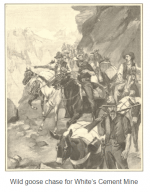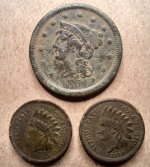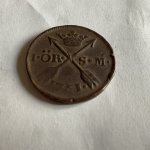KGCnewbieseeker
Sr. Member
Pure, native gold occurs in nature in only a few types of deposits. The most important of these include vein and fracture fillings, replacement bodies, pipe or "chimney" deposits, stockworks, saddle reefs, and placer deposits. In most hypogene (or primary) deposits, the matrix or gangue minerals are usually quartz and calcite. Gold is almost invariably associated with igneous rocks of intermediate to silicic composition. This knowledge guides prospectors in their search for the yellow metal. In general, they look for outcrops of highly altered rock containing veins, replacement bodies, reefs, or stockworks. Since most hypogene mineral deposits are derived from a magma source, an igneous intrusion of dioritic to granitic composition is almost always nearby. The ore deposits may be emplaced within the igneous body itself or within the surrounding country rock.
Eventually prospectors came to recognize the classic types of gold-bearing ore bodies. But what about nuggets of native gold in a light-colored, cement-like matrix? Can such a thing be possible? The geology of most gold-bearing ore bodies argues against it, but as everyone knows, gold is where you find it! In the history of mining in the Old West, at least three incredible ledges of gold-bearing cement-like ore have been discovered. Unfortunately, all three were lost soon after their initial discovery, but samples of ore were collected from each and all have survived.
One of the most famous of the gold-bearing cement ledges is the Lost Cement Mine in the Mammoth Lakes country of east-central California. Located somewhere in the Ritter Range south of Mono Lake, the Lost Cement Mine gained a legendary status in the gold camps of California.
Another of the famous ledges of gold-bearing cement lies at the southern end of the Panamint Range in Death Valley. Known as the Lost Mine of Manly Peak, the rich ledge was discovered in 1925 by Asa M. Russell and Ernie Huhn. When the two prospectors returned to Manly Peak to work the mine, they were unable to find it.
A third ledge of incredibly rich gold-bearing cement lies somewhere in the rugged Sangre de Cristo Mountains of southern Colorado, just north of the New Mexico border. Known as the Lost White Cement Mine, the fabulous ledge yielded samples of ore containing 1000 ounces of gold per ton! And like all the other gold-bearing cement ledges, the ore consisted of nuggets and grains of pure gold in a "cement-like" matrix.
During the summer of 1858, a party of prospectors led by Henry Sharron was camped in a canyon known as Horsehead Gulch, in northeastern New Mexico. One hot day in July, an old prospector stumbled into their camp, more dead than alive. The men at the camp nursed the old man back to health and soon found that he had a fantastic tale to tell.
The old prospector's name was White. He told the men in the camp that he had journeyed west in 1849 to seek his fortune in the gold fields of California. But after several years of disappointment, he decided to return home. It was well that he did so. While passing through the mountains of southern Colorado, he made the discovery of a lifetime. Somewhere back in those mountains, a few days northwest of Horsehead Gulch, White found a fabulous ledge of gold-bearing white "cement". The old man gathered a sackful of some of the best samples and continued southeastward out of the mountains. He became disoriented and eventually stumbled into the Sharron party's camp.
White showed the prospectors some of his ore. To their amazement, the ore was indeed cement-like in appearance. It looked like white cement speckled with gold! The ore was analyzed by the camp assayer and found to be extremely rich. Of course, the Sharron party worked themselves into a frenzy over this strange-looking ore. They managed to coerce the old man into leading them back to the mine where they would work the deposit together. The Sharron party offered old man White the richest and choicest part of the claim while they would split up the remainder. Unfortunately for the Sharron party, the old man began to have afterthoughts. On the third day of travel, near the Colorado/New Mexico border, White disappeared. He was never seen again. Just before he left, White had indicated that the ledge was only a day's journey away. The Sharron party therefore continued northwestward into the mountains in an attempt to find the deposit. They were unsuccessful. Although they combed the area, they were unable to find any cement-like deposits. The Lost White Cement Mine remains hidden to this day.
Eventually prospectors came to recognize the classic types of gold-bearing ore bodies. But what about nuggets of native gold in a light-colored, cement-like matrix? Can such a thing be possible? The geology of most gold-bearing ore bodies argues against it, but as everyone knows, gold is where you find it! In the history of mining in the Old West, at least three incredible ledges of gold-bearing cement-like ore have been discovered. Unfortunately, all three were lost soon after their initial discovery, but samples of ore were collected from each and all have survived.
One of the most famous of the gold-bearing cement ledges is the Lost Cement Mine in the Mammoth Lakes country of east-central California. Located somewhere in the Ritter Range south of Mono Lake, the Lost Cement Mine gained a legendary status in the gold camps of California.
Another of the famous ledges of gold-bearing cement lies at the southern end of the Panamint Range in Death Valley. Known as the Lost Mine of Manly Peak, the rich ledge was discovered in 1925 by Asa M. Russell and Ernie Huhn. When the two prospectors returned to Manly Peak to work the mine, they were unable to find it.
A third ledge of incredibly rich gold-bearing cement lies somewhere in the rugged Sangre de Cristo Mountains of southern Colorado, just north of the New Mexico border. Known as the Lost White Cement Mine, the fabulous ledge yielded samples of ore containing 1000 ounces of gold per ton! And like all the other gold-bearing cement ledges, the ore consisted of nuggets and grains of pure gold in a "cement-like" matrix.
During the summer of 1858, a party of prospectors led by Henry Sharron was camped in a canyon known as Horsehead Gulch, in northeastern New Mexico. One hot day in July, an old prospector stumbled into their camp, more dead than alive. The men at the camp nursed the old man back to health and soon found that he had a fantastic tale to tell.
The old prospector's name was White. He told the men in the camp that he had journeyed west in 1849 to seek his fortune in the gold fields of California. But after several years of disappointment, he decided to return home. It was well that he did so. While passing through the mountains of southern Colorado, he made the discovery of a lifetime. Somewhere back in those mountains, a few days northwest of Horsehead Gulch, White found a fabulous ledge of gold-bearing white "cement". The old man gathered a sackful of some of the best samples and continued southeastward out of the mountains. He became disoriented and eventually stumbled into the Sharron party's camp.
White showed the prospectors some of his ore. To their amazement, the ore was indeed cement-like in appearance. It looked like white cement speckled with gold! The ore was analyzed by the camp assayer and found to be extremely rich. Of course, the Sharron party worked themselves into a frenzy over this strange-looking ore. They managed to coerce the old man into leading them back to the mine where they would work the deposit together. The Sharron party offered old man White the richest and choicest part of the claim while they would split up the remainder. Unfortunately for the Sharron party, the old man began to have afterthoughts. On the third day of travel, near the Colorado/New Mexico border, White disappeared. He was never seen again. Just before he left, White had indicated that the ledge was only a day's journey away. The Sharron party therefore continued northwestward into the mountains in an attempt to find the deposit. They were unsuccessful. Although they combed the area, they were unable to find any cement-like deposits. The Lost White Cement Mine remains hidden to this day.






